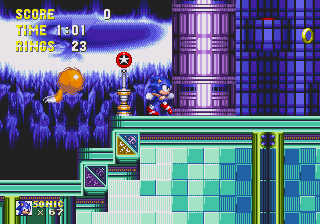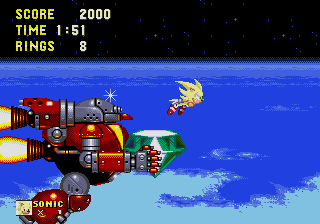 |
| Not actually S3&K, but let's thank Nerkin anyway for daring to dream the HD dream |
I'm not going to spend long waxing lyrical about S3&K's lock-on technology, as it's pretty well known by now; originally planned as one game, Sega realised that they couldn't fit Sonic 3 on to one cartridge without having to spend ridiculous amounts of money making a bigger one. Instead they split the game into two, renamed the second part to Sonic & Knuckles and gave it a slot on top of the cartridge itself, allowing players to plug in the preceding game and combine them into one single, seamless experience.
The result was legendary; not only could players get the full Sonic 3 experience, but they could also play through Sonic 2 as Knuckles, making Sonic & Knuckles an expansion pack for not one, but two games. Three in fact, if you count the ability to lock on to Sonic 1 and play a selection of brand-new special stages.
But this is old news; Sega have re-released the 16-bit Sonic games every single console generation, including the ability to 'lock-on' with Sonic & Knuckles, so there isn't much that needs saying about that particular innovation. But what does need talking about is that S3&K is an early and still extremely relevant example of voiceless storytelling, the kind that video games excel at and Sonic has proven to be a prime example of.
Not that it tells a complicated story, of course. Having brought down the Death Egg, Sonic and Tails investigate why it hasn't crashed down to earth; discovering the mysterious Floating Island, they soon discover that Eggman has tricked the island's guardian, Knuckles, into believing that the eponymous heroes are the bad guys, forcing the two to circumnavigate the island as Knuckles steals the Chaos Emeralds from them and throws a variety of obstacles in their path.
It isn't much of a narrative, but it contains plot twists, betrayal, epic set pieces and a sense of urgency that creates a tangible sense of progression and adventure beyond that of any game released at the time and arguably since - not without resorting to text and dialogue, at least. Therein lies the genius of S3&K, and the reason why it is still so relevant to video games today - it's a timeless example that will never stop being so. While Half Life 2 told a coherent story without resorting to cut-scenes, S3&K went a step further.
 |
| Details like the Death Egg in the background give a real sense of progression throughout the game |
The result is an extremely coherent adventure, one that clearly marks the position of each location in relation to each other and creates the sensation of a continuous, unbroken adventure without resorting to maps or any other such contrivance. The beauty of video games lies in their ability to instil a sense of wonderment and excitement into the player, much like music pushing a person's various emotional buttons, and S3&K is a perfect combination of exhilaration, adventurousness and scale, combining to make the Floating Island feel like a gigantic, living environment, one where your actions and progress are of the greatest importance.
The best example comes near the climax of the game, in Lava Reef. The fiery cavern becomes a frozen wasteland after just one Act, complemented by a haunting melody - just what the hell happened to it? Drawn on by this mystery, the player soon finds themselves hurled into a lower cavern by Knuckles - the same cavern where the Death Egg crash-landed.
Nothing seems particularly remiss, until the eyes of the space station flare into life. With a flash of energy, the cavern itself bursts into flames, forcing the player to dodge lava and avoid crumbling ledges. At no point in the game, nor its instruction booklet, are we told what the Death Egg can actually do - the same goes for its predecessor, where the Death Egg was first introduced. But here in Lava Reef, Sega shows the player exactly what it does, actively involving the player in this turn of events in show-stopping manner.
 |
| This is what 16-bit dreams were made of |
And bear in mind that this is in a game of blocky pixels, limited animations and a completely fixed viewpoint; video games of the old school didn't have a lot to work with when it came to telling a story, despite games like Ninja Gaiden giving us the dynamic cut-scene and Final Fantasy getting busy with telling more and more complex stories as the series went on. The use of gameplay, design and changing visual and aural cues are the tools with which video games can craft an experience unique to that medium; with that in mind, the atmosphere and storytelling devices of S3&K are quintessential justifications for the relevance of games, and there are lessons to be learned from Sonic's third adventure that will never, ever stop being relevant.
The first Sonic game earned its place as a title that helped drag video games into the public consciousness, while its sequel is a perfect blend of old-school gameplay, graphics and music. But it's the third iteration, the two-part, multi-cartridge monstrosity that marks the pinnacle of what Sega's hedgehog has done for gaming. Every generation gamers lap up these same four games over and over, and long may this continue.
Because gaming owes this hedgehog a debt; if we should ever forget it, then we will be all the worse for it.

No comments:
Post a Comment
I have a hungry ego to feed; please give generously